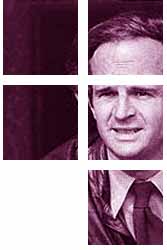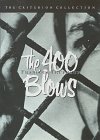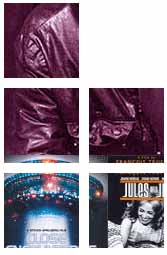





| DVD | click here
for vhs
|
 |
400
Blows
Francois Truffaut's first feature was this 1959 portrait of Antoine Doinel (Jean-Pierre Léaud), a boy who turns to petty crime in the face of neglect at home and hard times at a reform school. Somewhat autobiographical for its director, the film helped usher in the heady spirit of the French New Wave, and introduced the Doinel character, who became a fixture in Truffaut's movies over the years. Poignant, exhilarating, and fun (there's a parade of cameo appearances from some of the essential icons and directors from the movement), this film is an important classic.
|
 |
Jules and Jim
This boxed set of seven films by François Truffaut (five features and two short films) includes a selection of classic and lesser-known titles from the master of the French New Wave. Jules and Jim is considered by many to be the director's masterpiece. Jeanne Moreau is superb as Catherine, an enigmatic woman who comes between two friends in this exquisitely paced story of a doomed love triangle. The Woman Next Door, made 20 years later in 1981, also explores the potentially destructive power of love. Gérard Depardieu plays a married man whose life is turned upside down by the return of a former lover. A third film explores the dark side of passion--The Soft Skin, made in 1964. When a successful, married publisher (Jean Desailly) embarks on an affair with an airline stewardess, deception, jealousy, and passion combine to create a potentially lethal cocktail. Three films in this set trace the life of Antoine Doinel, a character who first appeared in Truffaut's The 400 Blows. Antoine and Colette, originally part of an episodic film by several directors entitled L'Amour à vingt ans (1962), appears here with another charming short film, Les Mistons (1957). In Stolen Kisses (1968), Antoine is in his twenties, just out of the army, and looking for love and employment, while in Bed and Board (1970), he has married and has a child, although parenthood hasn't made him any more mature. These films document an extraordinary collaboration between Truffaut and actor Jean-Pierre Leaud, together creating one of the most fascinating and enduring characters in cinema.
|
 |
The
Story of Adele H
François Truffaut's dramatization of the true story of Adele Hugo, the daughter of French author-in-exile Victor Hugo, and her romantic obsession with a young French officer is a cinematically beautiful and emotionally wrenching portrait of a headstrong but unstable young woman. Adele (Isabelle Adjani, whose pale face gives her the quality of a cameo portrait) travels under a false name and spins a half-dozen false stories about herself and her relationship to Lieutenant Pinson (Bruce Robinson), the Hussar she follows to Halifax, Nova Scotia. Pinson no longer loves her, but she refuses to accept his rejection. Sinking farther and farther into her own internal world, she passes herself off as his wife and pours out her stormy emotions into a personal journal filled with delusional descriptions of her fantasy life. Beautifully shot by Nestor Almendros in vivid color, Truffaut's re-creation of the 1860s is accomplished not merely in impressive sets and locations but in the very style of the film: narration and voiceovers, written journal entries and letters, journeys and locations established with map reproductions, and a judicious use of stills mix old-fashioned cinematic technique with poetic flourishes. The result is one of Truffaut's most haunting portraits, all the more powerful because it's true.
|
 |
The
Woman Next Door
Depardieu and Ardant are paired in this movie, and not for the last time, and produce a grotesque story of obsession between former and now reunited lovers. Ardant's character is married, and her older, boring husband is beginning to suspect that she has feelings for another man. If you conclude from this movie that the French are so much in love with being in love that they are not outraged even when love kills, I won't argue with you. "The Woman Next Door" is about forbidden love and fatal attraction. It is a movie about two people who are lost in the world without love, but who cannot love in this world.
|
 |
The
WIld Child
François Truffaut's fascinating 1969 film, based on a real-life, 18th-century behavioral scientist's efforts to turn a feral boy into a civilized specimen, is an ingenious and poignant experience. In a piece of resonant casting that immediately turns this story into an echo of the creative process, Truffaut himself plays Dr. Itard, a specialist in the teaching of the deaf. Itard takes in a young lad (Jean-Pierre Cargol) found to have been living like an animal in the woods all his life. In the spirit of social experiment, Itard uses rewards and punishments to retool the boy's very existence into something that will impress the world. Beautifully photographed in black and white and making evocative use of such charmingly antiquated filmmaking methods as the iris shot, The Wild Child has a semidocumentary form that barely veils Truffaut's confessional slant. What does it mean to turn the raw material of life into a monument to one's own experience and bias? The question has all sorts of intriguing reverberations when one considers that Truffaut's own wild childhood was rescued by love of the cinema and that a degree of verisimilitude factors into his films starring Jean-Pierre Leaud--the troubled lad who grew up in Truffaut's work from The 400 Blows onward.
|
 |
Small
Change
Critic Pauline Kael neatly summed up the timeless appeal of François Truffaut's 1976 film by calling it "that rarity--a poetic comedy that's really funny." In other words, Truffaut's brilliant, upbeat study of resilient children in a French village is both artistically satisfying and joyously entertaining, proving yet again (after his acclaimed debut film The 400 Blows) that few directors remembered and understood the experience of childhood as clearly as Truffaut. The film's episodic structure reveals its young characters gradually, leaving them and returning to them as their individual stories unfold. Most of the sketches are hilarious (as when a little girl uses a megaphone to announce that she's been "abandoned," resulting in generous gifts of food from her surrounding neighbors), but there's also a story about a boy with abusive parents who learns to survive by his own ingenuity. Throughout, this remarkable film gets all the details precisely right, featuring a youthful cast of kids who don't seem to be acting at all. It's as if Truffaut had somehow gained privileged entrance into their world, and they carried on as if the camera simply wasn't there. |
 |
Love
On The Run
This was François Truffaut's last film in the Antoine Doinel series (the character followed from The 400 Blows to Bed and Board). Doinel is again played by Jean-Pierre Léaud as a bad boy whose own obsessions with his mother greatly affect his relationships with women. Here, our compulsive liar and general scamp is found out, time and time again, but, as the women of the film find, it's impossible to blame him entirely. In fact, it seems a French badge of honor to have your mistress show up at your door. The film stands on its own as a light and gentle comedy but carries much more resonance if watched in its proper place and order in the series. It also stars the devastatingly gorgeous Marie-France Pisier as an old acquaintance who calls Doinel on the carpet.
|
 |
The
Soft Skin
François Truffaut's cool, creamy-smooth melodrama of a doomed affair sets the lush romanticism of exciting indiscretion in a world where sudden stabs of ominous music hint at a tragedy in the making. Jean Desailly is a famous literary critic and publisher who becomes entranced with the lithe, strikingly beautiful flight attendant (Françoise Dorleac) who keeps crisscrossing his path while he's away on a speaking engagement. He's middle-aged, successful, and seemingly happily married with a wife and daughter, but he plunges ahead with an affair, careful to avoid friends and familiar places. The Soft Skin is not really a thriller, but Truffaut invests it with Hitchcockian echoes of guilt and fear of discovery, and he meticulously plots scenes with the precision of a heist film. Pulling back the veneer of chic elegance and attractive confidence, Desailly emerges not so much sordid as vain and pathetic, and his wife (Nelly Benedetti) comes into her own with her heartbreaking discovery of his lies. At once angry, hurt, and threatened, she grasps at reconciliation while sabotaging her own efforts with frustrated attacks. It's an unusual film with sudden changes in tone that do little to prepare the viewer for the dark climax: the tragic side of Truffaut's fascination with philandering men that runs throughout his career. Fans will recognize the scene with the kitten who licks off the plate set out for room service--he re-created it in Day for Night.
|
 |
The
Bride Wore Black
François Truffaut's 1968 thriller was an attempt to reconcile the exclusive experience of the Hitchcockian hero with the expansiveness of Jean Renoir's view of flawed humanity. Jeanne Moreau stars as a newlywed whose husband is shot dead on the church steps following their wedding. The story then follows her systematic and relentless efforts to track down the men who were involved in the killing, murdering each one with a creative efficiency that Truffaut does not mean for us to take too seriously. The film's real point is the interesting tension between the audience's growing knowledge about and sympathy toward the guilty fellows, who really are rather ordinary people, and the narrative hook concerning the heroine's reinvention into a figure of insulated emotion and revenge. (Moreau's character resembles nothing so much as the pathological but vulnerable title character of Hitchcock's Marnie.) The Bride Wore Black (based on a novel by Cornell Woolrich) is not meant to be taken as an object lesson in irony, however. In the finest and most entertaining tradition of Hollywood movies (certainly most of Hitchcock's movies), one can watch Truffaut's film without giving a thought to anything other than its own smooth movement. Take a step back, however, and there are riches to be explored.
|
 |
Bed
& Board: Domicile Conjugal
The fourth film in François Truffaut's quasi-autobiographical Antoine Doinel cycle finds the idealistic child-man (played by Truffaut's alter ego and French new wave icon Jean-Pierre Léaud) married to his sweetheart Christine (Claude Jade) and still plugging away at odd jobs. When his experiments in the florist trade burn his bouquets to a smoky black ruin, he decides that it's time for another trade, and lands a job sending radio-controlled toy boats around a miniature harbor mock-up. It's about that time that he learns of his impending fatherhood, but he throws a monkey wrench into his new happiness when he becomes obsessed with a beautiful young Japanese woman (Hiroku Berghauer). Truffaut enlivens Doinel's courtyard apartment with the bustle and business of neighbors, creating a warm sense of community reminiscent of the works of Jean Renoir. He also pays homage to comic auteur Jacques Tati in meticulously constructed comic bits and a hilarious cameo by Tati's famous character, M. Hulot. However, he tempers the giddy screwball kookiness that characterized the previous film in the cycle, Stolen Kisses, with a less forgiving disposition toward Antoine's passionate irresponsibility and emotional impulsiveness. In one of Truffaut's finest moments ever, he plays out a conversation between the separated but still in love couple with a hard-earned sense of reflective maturity: "I love you," she confesses, "but I don't want to see you." It's a comedy with serious edges as Truffaut decides it's time for Antoine to grow up.
|
 |
Two
English Girls
François Truffaut's adept handling of language and art, sex and caprice, is in full flower in Two English Girls, an adaptation of the Henri-Pierre Roché novel. Claude (Truffaut favorite Jean-Pierre Léaud) is a Frenchman persuaded by Ann (Kika Markham) to come to England to meet her sister, Muriel (Stacey Tendeter). Claude falls for both sisters, vacillating between the two with a kind of Brontë indecisivenes, but he ends up asking for Muriel's hand. Complications arise, forcing all three of them to separate ends but with many reunions along the way. Truffaut said he wanted to "make not a film on physical love, but a physical film on love." He teases and taunts, making pastoral scenes erotic and erotic scenes pastoral and never loses momentum or weight with the story. Largely dismissed or ignored after its release in 1971, the film has wisely been reassessed to take its place as one of Truffaut's finest. It also includes a magnificent score by Georges Delerue (who appears briefly in the film) and stands as possibly one of the last cautionary cause-and-effect tales of the evils of masturbation and poor eyesight.
|
 |
Mississippi
Mermaid
Jean-Paul Belmondo stars as the owner of a cigarette factory on an African island, and a single man who advertises for a wife and, voilà, gets Catherine Deneuve. Problem is, however, she isn't quite what she seems in this 1969 drama by François Truffaut, taken from a Cornell Woolrich novel called Waltz into Darkness. Suspicions lead to deception and deception to murder, and along the way Belmondo's character, despite everything, continues to fall in love with his enigmatic prize, which is really the point of the film: the protagonist, almost as if he were willing himself into a noir myth, seems determined to fall under the spell of a romantic delusion. A fine effort by Truffaut that is the best of his mid-period pulpy, suspense films
|
 |
Eight years after the wry romantic sketch Antoine and Colette, François Truffaut and Jean-Pierre Léaud reunited to catch up with Truffaut's cinematic alter ego, Antoine Doinel, the troubled adolescent of The 400 Blows. Stolen Kisses opens with the now-grown Doinel sprung from military prison with a dishonorable discharge, drawn directly from Truffaut's own history of delinquency, but the parallels end there. Lovesick Doinel woos the perky but unresponsive object of his affections, Christine (Claude Jade) while he engages in a series of professions--hotel night watchman, private investigator, TV repairman--with mixed success and comic entanglements. But when he falls in love with the elegant wife of his client (Delphine Seyrig at her most beautiful and charming), Christine realizes she misses Antoine's persistence and clumsy passes, so she embarks on a seductive plan of her own. Truffaut's comic confection is full of deadpan gags and screwball chaos, a world away from the heavy seriousness of The 400 Blows, and Léaud is endearingly naive as the determined Doinel, forging ahead with more pluck and passion than aptitude. It may be Truffaut's most sweetly romantic film, a knowing man's embrace of eager innocence and storybook sentiment. Doinel returns two years later in Bed and Board. |
 |
Scientist Bertrand Morane, "never in the company of men after 5," seduces women by evening and writes about the experiences in the early morning. Though 40ish and somewhat square, no woman in the town of Montpelier seems capable of resisting his earnest advances. Not much else happens in The Man Who Loved Women, but in the hands of master visual storyteller François Truffaut, the threadbare plot accumulates deep and ominous philosophical resonances. What drives Morane from woman to woman, and what accounts for his remarkable success? Does he secretly dislike women and consider them interchangeable (as one of the more prurient characters charges, to Morane's genuine befuddlement), or is his enthusiasm a kind of celebration? Truffaut refuses to answer plainly, but does drop clues; as his camera focuses on everyday objects, many take on a chilling, otherwordly luster, and coldly foreshadow Morane's fate. A deceptively simple film, The Man Who Loved Women is neither an indictment nor an apology for philandering; rather, it's a courageous, lovingly detailed portrait of a complex, intelligent man suffering from an altogether intractable complaint. This film was clumsily remade in English in 1983 by Blake Edwards, with Burt Reynolds assuming the role played here with such understated skill by the wonderful Charles Denner. |
 |
Two Short Films By Francois Truffaut: Les Mistons/Antoine François Truffaut's 1957 short "Les Mistons" (roughly translated to "The Brats") is an early testament to Truffaut's affinity with kids and his first exploration of impossible love. Five boys palling around one summer fall for a teen beauty, but as the narrator (one of the five) describes, "Too young to love Bernadette, we decided to hate her--and torment her." These adolescent boys are neither cute nor innocent, but Truffaut sympathizes with the frustration born of budding hormones and sexual mystery. In 1962, he revisited similar territory in the sketch "Antoine and Collette." The second film to feature alter ego Antoine Doinel (Jean-Pierre Léaud), it was originally made for the omnibus film Love at Twenty but has outlived its companion shorts. As romantic and gently ironic as The 400 Blows is harsh and haunting, this modest 20-minute lark finds a teenage Antoine pursuing the lovely, lithe 20-year-old Colette (Marie-France Pisier) like a lovesick puppy dog. The comic sweetness of this episode sets the tone for all future Doinel films, and Léaud, who matured into the poster boy for the French new wave, displays the lanky charm and self-effacing egotism that propelled him through some of the greatest films of the next two decades. |
 |
A man runs through deserted night streets, stalked by the lights of a car. It's a definitive film noir situation, promptly sidetracked--yet curiously not undercut--by real-life slapstick: watching over his shoulder for pursuers, the running man charges smack into a lamppost. The figure that helps him to his feet is not one of the pursuers (they've oddly disappeared) but an anonymous passerby, who proceeds to escort him for a block or two, genially schmoozing about the mundane, slow-blooming glories of marriage. The Good Samaritan departs at the next turning, never to be identified and never to be seen again. And the first man--who, despite this evocative introduction, is not even destined to be the main character of the movie--immediately resumes his helter-skelter flight from an as-yet-unspecified and unseen menace. The opening of Shoot the Piano Player, François Truffaut's second feature film, is one of the signal moments of the French New Wave--an inspired intersection of grim fatality and happy accident, location shooting and lurid melodrama, movie convention and frowzy, uncontainable life. At this point in his career--right after The 400 Blows, just before his great Jules and Jim--the world seemed wide for Truffaut, as wide as the Dyaliscope screen that he and cinematographer Raoul Coutard deployed with unprecedented spontaneity and lyricism. Anything might wander into frame and become part of the flow: an oddball digression, an unexpected change of mood, a small miracle of poetic insight. The official agenda of the movie is adapting a noirish story by American writer David Goodis, about a celebrated concert musician (Charles Aznavour) hiding out as a piano player in a saloon. He's on the run as much as the guy--his older brother--in the first scene. But whereas the brother is worried about a couple of buffoonish gangsters, Charlie Koller is ducking out on life, love, and the possibility that he might be hurt, or cause hurt, again. Decades after its original release, Shoot the Piano Player remains as fresh, exhilarating, and heartbreaking--as open to the magic of movies and life--as ever. - |
 |
François Truffaut's last film is both a homage and a lark. Without the brooding poutiness it's a homage to Alfred Hitchcock, and it's possible to watch this film just for the parallels or outright hat-tipping that goes on. It's the story of an older, hapless real-estate agent, Vercel (Jean-Louis Trintignant), under suspicion for a ruthless murder. Since this is a black-and-white, subtitled French film, the agent's voluptuous, intelligent secretary (a sharp and sexy Fanny Ardant) is hopelessly in love with him. While he hides out in the back office, she tries to get to the bottom of the crime; this is not so much a whodunit as a cinematic treat about the conventions and setups of film noir. Under the beautiful cinematography of Néstor Almendros, this is a film rainy Sunday afternoons were made for.
|
 |
The classic science fiction novel by Ray Bradbury was a curious choice for one of the leading directors of the French New Wave, François Truffaut. But from the opening credits onward (spoken, not written on screen), Truffaut takes Bradbury's fascinating premise and makes it his own. The futuristic society depicted in Fahrenheit 451 is a culture without books. Firemen still race around in red trucks and wear helmets, but their job is to start fires: they ferret out forbidden stashes of books, douse them with gasoline, and make public bonfires. Oskar Werner, the star of Truffaut's Jules and Jim, plays a fireman named Montag, whose exposure to David Copperfield wakens an instinct toward reading and individual thought. (That's why books are banned--they give people too many ideas.) In an intriguing casting flourish, Julie Christie plays two roles: Montag's bored, drugged-up wife and the woman who helps kindle the spark of rebellion. The great Bernard Herrmann wrote the hard-driving music; Nicolas Roeg provided the cinematography. Fahrenheit 451 received a cool critical reception and has never quite been accepted by Truffaut fans or sci-fi buffs. Its deliberately listless manner has always been a problem, although that is part of its point; the lack of reading has made people dry and empty. If the movie is a bit stiff (Truffaut did not speak English well and never tried another project in English), it nevertheless is full of intriguing touches, and the ending is lyrical and haunting. |
 |
François Truffaut again tackles the elusive nature of creativity and the elusive creation in this thoughtful, sumptuous, 1980 film. Nominated for the Best Foreign Language film Oscar, and a winner of various Césars, The Last Metro is a tale of the theater in occupied France during World War II. Marion Steiner (Catherine Deneuve) manages the Theatre Montmarte in the stead of her Jewish husband, director Lucas Steiner (Heinz Bennent). He has purportedly fled France but is really hiding out in the basement of the theater. The one hope to save the Montmarte is a new play starring the dashing Bernard Granger (Gérard Depardieu). The attraction between Marion and Bernard is palpable, and as usual Truffaut creates tension and drama from even the most casual of occurrences. The theme of the director locked away while his lover and his creation are appropriated by others makes for interesting Truffaut study, but first and foremost this is a well-spun romance. |

|
Close
Encounters of the Third Kind
Anybody who has written him off because of his string of stinkers--or anybody who's too young to remember The Goodbye Girl--may be shocked at the accomplishment and nuance of Richard Dreyfuss's performance in Close Encounters of the Third Kind. Here, he plays a man possessed; contacted by aliens, he (along with other members of the "chosen") is drawn toward the site of the incipient landing: Devil's Tower, in rural Wyoming. As in many Spielberg films, there are no personalized enemies; the struggle is between those who have been called and a scientific establishment that seeks to protect them by keeping them away from the arriving spacecraft. The ship, and the special effects in general, are every bit as jaw-dropping on the small screen as they were in the theater (well, almost). Released in 1977 as a cerebral alternative to the swashbuckling science fiction epics then in vogue, Close Encounters now seems almost wholesome in its representation of alien contact and interested less in philosophizing about extraterrestrials than it is in examining the nature of the inner "call." Ultimately a motion picture about the obsession of the driven artist or determined visionary, Close Encounters comes complete with the stock Spielberg wives and girlfriends who seek to tether the dreamy, possessed protagonists to the more mundane concerns of the everyday. So a spectacular, seminal motion picture indeed, but one with gender politics that are all too terrestrial.
|
 |
The 400 Blows - Criterion Collection Francois Truffaut's first feature was this 1959 portrait of Antoine Doinel (Jean-Pierre Léaud), a boy who turns to petty crime in the face of neglect at home and hard times at a reform school. Somewhat autobiographical for its director, the film helped usher in the heady spirit of the French New Wave, and introduced the Doinel character, who became a fixture in Truffaut's movies over the years. Poignant, exhilarating, and fun (there's a parade of cameo appearances from some of the essential icons and directors from the movement), this film is an important classic. |


